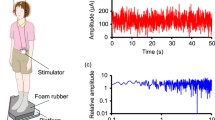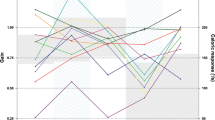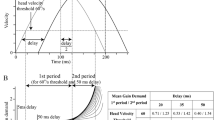Abstract
In humans, habituation of vestibulo-ocular reflex (VOR) by repeated caloric or rotational stimulation has been well documented. However, less attention has been directed to the effect of habituation on the sensation of self-rotation and little is known about the retention duration of vestibular habituation. To investigate these characteristics, subjects were exposed to ten sessions of angular velocity steps in yaw, with a chair rotating either alternatively in both CW and CCW directions (bidirectional protocol) or always in the same direction (unidirectional protocol), i.e., CW or CCW. The retention of habituation of VOR and sensation of rotation induced by both protocols was studied for a period up to 8 months following the end of the habituation protocols. There was a progressive decline in the VOR peak slow phase velocity and time constant throughout the sessions during both protocols. These parameters then followed an exponential recovery with a time constant of about 1 month. The duration of the sensation of rotation also habituated during repeated angular velocity steps, but it was shorter for both directions of stimulation, including after the unidirectional protocol. Sinusoidal VOR gain was not affected by vestibular habituation to velocity steps, but sinusoidal VOR phase showed an increase in phase lead at 0.02 and 0.04 Hz, which also returned to baseline values within about 1 month. We conclude that vestibular habituation is a long-lasting phenomenon. These results may be helpful for designing and scheduling the protocols for drug studies using crossover design, rehabilitation of balance disorder patients, and for the application of intermittent artificial gravity during space missions.




Similar content being viewed by others
References
Aschan G (1954) Response to rotatory stimuli in fighter pilots. Acta Otolaryngol (Suppl) 116:24–31
Blair S, Gavin M (1979) Response of the vestibulo-ocular reflex to differing programs of acceleration. Invest Ophtalmol Vis Sci 18:1086–1090
Brandt T, Dieterich M (1999) The vestibular cortex: its locations, functions, and disorders. Ann NY Acad Sci 871:293–312
Clément G, Bukley A (2007) Artificial Gravity. Microcosm Inc, Hawthorne and Springer, New York
Clément G, Courjon JH, Jeannerod M, Schmid R (1981) Unidirectional habituation of vestibulo-ocular responses by repeated rotational or optokinetic stimulations in the cat. Exp Brain Res 42:34–42
Clément G, Deguine O, Parant M, Costes-Salon MC, Vasseur-Clausen P, Pavy Le Traon A (2001) Effects of cosmonaut vestibular training on vestibular function prior to spaceflight. Eur J Appl Physiol 85:539–545
Clément G, Flandrin JM, Courjon JH (2002) Comparison between habituation of the cat vestibulo-ocular reflex by velocity steps and sinusoidal vestibular stimulation in the dark. Exp Brain Res 142:259–267
Clément G, Deguine O, Bourg M, Pavy-LeTraon A (2006) Effects of vestibular training on motion sickness, nystagmus, and subjective vertical. J Vestib Res 16:1–14
Cohen H, Cohen B, Raphan T, Waespe W (1992) Habituation and adaptation of the vestibuloocular reflex: A model of differential control by the vestibulocerebellum. Exp Brain Res 90:526–538
Collins WE (1964) Task-control of arousal and the effects of repeated unidirectional angular acceleration on human vestibular responses. Acta Otolaryngol (Suppl) 190:3–34
Collins WE (1966) Vestibular responses from figure skaters. Aerospace Med 37:1098–1102
Collins WE (1973) Habituation of vestibular responses: An overview. Proc Fifth NASA Symp on The Role of the Vestibular Organs in Space Exploration, NASA SP-314:157–191
Collins WE (1974) Habituation of vestibular responses and visual stimulation. In: Kornhuber HH (ed) Handbook of sensory physiology, vol VI. Vestibular system. Springer, New York, pp 370–388
Courjon JH, Clément G, Schmid R (1985) The influence of interstimulus interval on the development of vestibular habituation to repeated velocity steps. Exp Brain Res 59:10–15
Cowings IS, Toscano WB (2000) Autogenic-feedback training exercise is superior to promethazine for control of motion sickness symptoms. J Clin Pharmacol 40:1154–1165
Crampton GH (1964) Habituation of ocular nystagmus of vestibular origin. In: Bender MB (ed) The oculomotor system. Harper & Row, New York, pp 332–346
Dai M, Kunin M, Raphan T, Cohen B (2003) The relation of motion sickness to the spatial-temporal properties of velocity storage. Exp Brain Res 151:173–189
Dieterich M, Bense S, Lutz S, Drzezga A, Stephan T, Bartenstein P, Brandt T (2003) Dominance for vestibular cortical function in the non-dominant hemisphere. Cereb Cortex 13:994–1007
Dodge R (1923) Habituation to rotation. J Exp Psychol 6:1–36
Fernandez C, Goldberg JM (1971) Physiology of peripheral neurons innervating semicircular canals of the squirrel monkey. II. Response to sinusoidal stimulation and dynamics of peripheral vestibular system. J Neurophysiol 34:661–675
Fluur E, Mendel L (1964) Habituation, efference and vestibular interplay. III. Unidirectional rotatory stimulation. Acta Otolaryngol 51:570–578
Griffith CR (1920) The organic effect of repeated bodily rotation. J Exp Psychol 3:15–47
Griffith CR (1924) A note on the persistence of the “practice effect” in rotation experiments. J Comp Psychol 4:137–149
Grunfeld EA, Okada T, Jauregui-Renauda K, Bronstein AM (2000) The effect of habituation and plane of rotation on vestibular perceptual responses. J Vestib Res 10:193–200
Guedry FE, Collins WE, Sheffey PL (1961) Perceptual and oculomotor reactions to interacting visual and vestibular stimulation. Percept Mot Skills 12:307–324
Guedry FE, Collins WE, Graybiel A (1964) Vestibular habituation during repetitive complex stimulation: A study of transfer effects. J Appl Physiol 19:1005–1015
Guedry FE (1965) Habituation to complex vestibular stimulation in man: Transfer and retention of effects from 12 days of rotation at 10 rpm. Percept Mot Skills (Suppl) 21:459–481
Guedry FE, Rupert AH, McGrath BJ, Oman CM (1992) The dynamics of spatial orientation during complex and changing linear and angular acceleration. J Vestib Res 2:259–283
Hallpike CS, Hood JD (1963) Fatigue and adaptation of the cupular mechanism of the human horizontal semicircular canal: an experimental investigation. Proc R Soc Lond 141B:542–561
Hood JD (1960) The neurophysiological significance of cupular adaptation and its bearing upon Ewald’s second law. Acta Otolaryngol (Suppl) 159:50–55
Jäger J, Henn V (1981) Habituation of the vestibulo-ocular reflex (VOR) in the monkey during sinusoidal rotation in the dark. Exp Brain Res 41:108–114
Jeannerod M, Magnin M, Schmid R, Stefanelli M (1976) Vestibular habituation to angular velocity steps in the cat. Biol Cybern 22:39–48
Lackner JR, Graybiel A (1994) Use of promethazine to hasten adaptation to provocative motion. J Clin Pharmacol 34:644–648
Lidvall HF (1961) Vertigo and nystagmus responses to caloric stimuli repeated at short intervals. Acta Otolaryngol 53:33–44
Melvill Jones G, Rolph R, Downing GH (1980) Comparison of human subjective and oculomotor responses to sinusoidal vertical linear acceleration. Acta Otolaryngol 90:431–440
Merfeld DM, Park S, Gianna-Poulin C, Black FO, Wood S (2005) Vestibular perception and action employ qualitatively different mechanisms. II: VOR and perceptual responses during combined tilt and translation. J Neurophysiol 94:199–205
Mert A, Bles W, Nooij SA (2007) Hyperventilation in a motion sickness desensitization program. Aviat Space Environ Med 78:505–509
Nilsson A (1972) Comparisons between oculogyral illusion, turning sensation and nystagmus within a process frame of reference. In: Anderson A, Wilson A, Ruuth E, Smith G (eds) Visual aftereffects and the individual as an adaptive system. CWK Gleerup, Lund, pp 125–134
Norre ME, Beckers A (1989) Vestibular habituation training: exercise treatment for vertigo based on habituation effect. Otolaryngol Head Neck Surg 101:14–20
Okada T, Grunfeld E, Shallo-Hoffmann J, Bronstein AM (1999) Vestibular perception of angular velocity in normal subjects and in patients with congenital nystagmus. Brain 122:1293–1303
Raphan T, Schnabolk C (1988) Modeling slow phase velocity generation during off-vertical axis rotation. Ann NY Acad Sci 545:29–50
Schmid R (1986) Habituation of the vestibulo-ocular responses to repeated vestibular stimulations in darkness. In: Ron S, Schmid R, Jeannerod M (eds) Sensorimotor plasticity. Theoretical, experimental and clinical aspects. Editions INSERM, Paris, pp 141–161
Schmid R, Jeannerod M (1985) Vestibular habituation: an adaptive process? In: Berthoz A, Melvill Jones G (eds) Adaptive mechanisms in Gaze control. Elsevier, New York, pp 113–122
Shepard NT, Telian SA, Smith-Wheelock M, Raj A (1993) Vestibular and balance rehabilitation therapy. Ann Otol Rhinol Laryngol 102:198–203
Takemori S, Ida M, Umezu H (1985) Vestibular training after sudden loss of vestibular functions. Oto Rhino Laryngol 47:76–83
Torte MP, Clément G, Courjon JH, Magenes G (1997) Absence of habituation of the vertical vestibulo-ocular reflex in the cat. Exp Brain Res 116:73–82
Vitte E, Semont A, Berthoz A (1994) Repeated optokinetic stimulation in conditions of active standing facilitates recovery from vestibular deficits. Exp Brain Res 102:141–148
Wendt GR (1951) Vestibular functions. In: Stevens SS (ed) Handbook of experimental psychology. Wiley, New York, pp 1191–1223
Wood S, Reschke MF, Sarmiento L, Clément G (2007) Tilt and translation motion perception during off-vertical axis rotation. Exp Brain Res 182:365–377
Young LR, Henn VS (1974) Selective habituation of vestibular nystagmus by visual stimulation. Acta Otolaryngol 77:159–166
Young LR, Sienko KH, Lyne LE, Hecht H, Natapoff A (2003) Adaptation of the vestibulo-ocular reflex, subjective tilt, and motion sickness to head movements during short-radius centrifugation. J Vestib Res 13:65–77
Acknowledgments
This research was supported by Institut National de la Santé et de la Recherche Médicale (INSERM), Centre National de la Recherche Scientifique (CNRS), Centre National d’Etudes Spatiales (CNES), and European Space Agency (ESA). This work was promoted by the Hospices Civils de Lyon under project no. HCL/P/2004.352/7.
Author information
Authors and Affiliations
Corresponding author
Rights and permissions
About this article
Cite this article
Clément, G., Tilikete, C. & Courjon, JH. Retention of habituation of vestibulo-ocular reflex and sensation of rotation in humans. Exp Brain Res 190, 307–315 (2008). https://doi.org/10.1007/s00221-008-1471-0
Received:
Accepted:
Published:
Issue Date:
DOI: https://doi.org/10.1007/s00221-008-1471-0




